 CIRCULAR
TIMES
CIRCULAR
TIMESAn International Networking Educational Institute
Intellectual, Scientific and Philosophical Studies
CIRCULAR TIMES HOMEPAGE CONTACT SITE NAVIGATION HIGHLIGHTED TABLE OF CONTENTS
NOTICE TO CT's NEW READING AUDIENCE: In the event you have come across
CIRCULAR TIMES on robertschoch.net
CIRCULAR TIMES ARCHIVES
“ . . . natural adapted features in a sanctified landscape.”
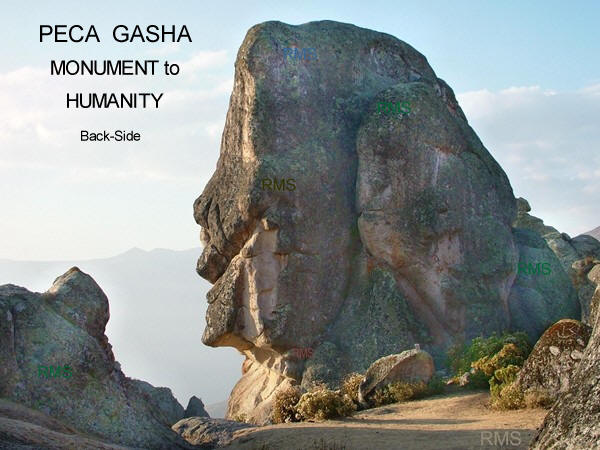
These words (from John Michell, Confessions of a Radical Traditionalist, 2005) resonated in my mind as I explored the Markawasi Plateau. I had come to this small plateau (about 2 miles long by a little over half a mile wide) in the Andes, towering above the town of San Pedro de Casta (50 miles northeast of Lima), at an elevation of over 12,000 feet above sea level, to view for myself the reputed ancient monumental stone sculptures. Here, some claimed, were to be found the remains of a lost culture that dates back thousands of years, if not tens of thousands of years or more.
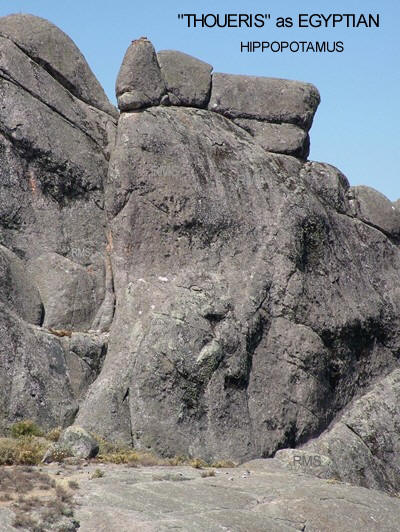
Supposedly they created monumental carvings from the granodiorite cliffs, boulders, and outcroppings on the top of the plateau – carvings of an anthropomorphic and zoomorphic nature, including peoples of many different races and animals found not just in the immediate vicinity, but from other continents as well. There was even an alleged sculpture of the Egyptian divinity Ta-urt (Thoueris), goddess of childbirth and maternity, in her typical form as an upright femalehippopotamus. If these reports were true, this would indicate a pre-Columbian culture that had transoceanic ties, and just perhaps it represented a branch of the primordial global lost civilization of which many writers and philosophers have speculated over the centuries. Certainly such reports piqued my interest, especially since I have championed both the concept of a very ancient high civilization and the idea of significant global contact among cultures long ago.
Before leaving the U.S., I was warned that Markawasi is a landscape of strange, anomalous phenomena, be they encounters with extraterrestrials (many UFOs, which the Peruvians refer to as ovni/ovnis, have been sighted from the plateau) or inhabitants of the reputed tunnels that lie beneath the Andes. Visitors to the plateau have experienced altered states of inner consciousness, accompanied by telepathic and clairvoyant abilities, whether in the dream or waking state. What might await me in this preternatural setting? [ THE STORY OF WHAT HAPPENED and What do you do about suicide? External link to the message board I was posting on trying to understand how to deal with all of this I was going through. CMD]
Markawasi has attracted the attention of some obscure, but nonetheless influential, figures in the arcane and occult sciences over the past fifty-some years. Foremost among these are Daniel Ruzo (1900-1993) and George Hunt Williamson (1926-1986).
Born in Lima, Daniel Ruzo was trained in law, but is best known for his studies of the esoteric, occult, and protohistory as exemplified by his interpretation of the monuments of Markawasi. Ruzo amassed a large collection of works by and about Nostradamus and wrote a book on the seer that went through a number of editions. He was also a 33rd degree Mason. Most importantly relative to Markawasi, however, Ruzo became convinced as early as 1924-1925 that an incredibly ancient culture once existed in Central and South America, almost entirely destroyed by a cataclysm many thousands of years ago - - a belief he based on traditions and legends passed down from pre-Spanish times. Perhaps the ancient culture was the American remnants or branch of a worldwide primordial culture, the lost civilization of primal times. It was from this long-forgotten culture, Ruzo suggested, that our present humanity inherited the roots of our own civilized ways. The few survivors of the cataclysm, which Ruzo thought might have been the same as the Biblical Noachian Flood, may have hidden in underground chambers, caves, and tunnels. Ruzo searched for physical evidence of this very ancient culture, from the time immemorial he referred to as protohistory. He thought he found such evidence in gigantic stone figures found along the Peruvian coast, but they were not clear enough to be convincing - - most people dismissed Ruzo’s “sculptures” as simply natural erosional features. It was all rather like seeing faces and animals among the clouds.
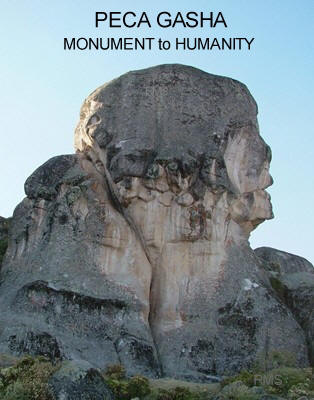
Ruzo called the protohistorical culture and people (or beings) he sought the Masma. The name was not original to Ruzo, but came to the Peruvian esoterist Pedro Astete (1871-1940) in a dream while he resided in Andahuaylas, Peru. In 1905 Astete dreamt of a huge, ancient subterranean hall, filled with scrolls containing the knowledge of the most ancient ones. And Astete heard a voice repeating the name “Masma.” Astete studied extensively myths, legends, and esoteric symbolism, and believed that sacred and mysterious treasures were buried in some cavern or tunnel system in the Huanca region of Peru. Astete lived in Buenos Aires, Argentina, from 1911-1923, and in 1913 a Buenos Aires periodical recounted another dream by a second person that matched in many features Astete’s dream of 1905. Furthermore, in 1915, Astete discovered that the name Masma has Biblical connections. Genesis 25:12-16 names Masma as the fifth (of twelve) sons of Ishmael (the son of Abraham) by the Egyptian Agar. Each of these twelve brothers was a ruler of his own tribe. Could the tribe of Masma have reached the Pacific coast of South America? Could the mysterious gold-producing land of Ophir, to which Solomon’s fleet traveled to return with gold (1 Kings 9:26-28), be located in modern Peru? Certainly Peru is known for her gold, and this was one of the prime factors bringing the Spanish Conquistadors to her borders.
Ruzo came to know Astete in the 1920s, and was convinced that the Masma of the
dream were real, and this was the protohistorical culture that he devoted most
of his life to uncovering. Despite his penetrating analyses of myth, legend,
and tradition, Ruzo made little headway uncovering physical evidence for the
Masma until 1952 when he was shown a photograph of what appeared to be an
enormous sculpted head. This was the Peca-Gasha, or “head of the narrow pass”
(Williamson, 1959, p. 34), of Markawasi, also sometimes referred to as “The Head
of the Inca,”
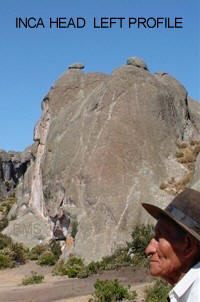 that
Ruzo and others would later refer to as the “Monument to Humanity.” Ruzo
quickly mounted a small expedition to Markawasi that year, and was stunned to
find not just the eighty feet tall Peca-Gasha, but also numerous other gigantic
sculptures in the rocks and cliffs of the plateau. Ruzo intensively studied the
Markawasi monuments from about 1953 to 1960, living on the plateau for extended
periods of time. He lectured about his findings at scientific conferences in
Mexico, Lima, and Paris; published scientific papers on the sculptures; and
wrote a book about Markawasi. Not everyone was convinced, however, and many
archaeologists continued to regard the supposed sculptures as natural landforms
sculpted by erosion. In some circles the subject became known as “Ruzo’s
Folly.”
that
Ruzo and others would later refer to as the “Monument to Humanity.” Ruzo
quickly mounted a small expedition to Markawasi that year, and was stunned to
find not just the eighty feet tall Peca-Gasha, but also numerous other gigantic
sculptures in the rocks and cliffs of the plateau. Ruzo intensively studied the
Markawasi monuments from about 1953 to 1960, living on the plateau for extended
periods of time. He lectured about his findings at scientific conferences in
Mexico, Lima, and Paris; published scientific papers on the sculptures; and
wrote a book about Markawasi. Not everyone was convinced, however, and many
archaeologists continued to regard the supposed sculptures as natural landforms
sculpted by erosion. In some circles the subject became known as “Ruzo’s
Folly.”
The Peca-Gesha is actually not just one head, but two major faces melded Janus-like, with one facing each way. These faces are evidently of different races, and according to Ruzo and others, at a dozen smaller faces of various races, nationalities, genders, and ages can be found on the structure, hence the name Monument to Humanity.
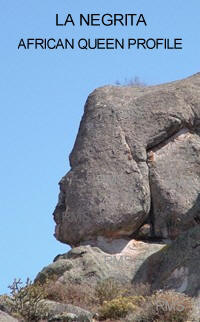
Ruzo later lived in Rio de Janeiro, Brazil, and then in Cuernavaca, Mexico, studying what he believed to be gigantic stone sculptures similar to those of Markawasi. He also traveled to Bolivia, France, England, Egypt, and Romania searching for, and finding, what he interpreted as very ancient and highly eroded (and thus not at all easily recognizable) megalithic sculptures of that pre-cataclysmic high culture.
George Hunt Williamson first popularized Markawasi among the English-speaking world in a chapter of his 1959 book Road in the Sky. Williamson based his account on a visit to the plateau in 1957, and his also had a chance to interview Dr. Ruzo (who then lived near Lima). Williamson, an advocate of UFO contact in ancient and modern times, associated the Markawasi structures with extraterrestrials and giants of past eons. Indeed, Road in the Sky is a book about extraterrestrial contact with humans on Earth, from ancient to modern times, with speculations on the future of such communion. For Williamson, Markawasi is a “Sacred Forest” in stone where the “gods” (extraterrestrials, or crosses between extraterrestrials and earthlings?) met to plan the future. In chapters following his discussion of Markawasi, Williamson discusses the famous Nazca lines of Peru which he regards as directional markers for extraterrestrial spacecraft (or as he puts it, “beacons for the ‘gods’ ”), supposed stylized maps of the surface of Mars found on Native American pottery, and many ancient and biblical references, legends, and reputed evidence for giants and unidentified flying objects. Williamson then shifts gears, relating a number of UFO sightings and encounters, taken from around the world, during the 1950s.
When you strip off the overlay of UFOlogy (and I will leave that to others to judge, though I remain extremely skeptical to say the least), Williamson emerges as both an extremely sensitive individual and also an influential occultist who espoused profound ideas amalgamated with trivial nonsense, exaggeration, misinterpretation, and perhaps a bit of down-right fraud, whether on the part of Williamson or his informants. Williamson relates a couple of personal experiences on the Markawasi Plateau that, based on both my own experiences and persons I had a chance to speak with firsthand (but whom prefer to remain anonymous, and I feel that is best at the moment), are not so farfetched. Excavating a mummy from a cave on the edge of Markawasi, Williamson suddenly felt a terrific pain on the right side of his head as if hit by a blow. Only after spending two and a half days in bed with a severe headache did Williamson come to discover that the mummy he had been excavating died of a wound and fracture to the right side of the head. At various times while on the plateau Williamson heard a strange, eerie humming sound that could not be attributed to insects (there were none), the wind, or any other normal cause. Others have heard this humming too, not only at Markawasi but also at diverse sacred ancient sites. It is sometimes attributed to energy, perhaps bound up in the crystalline structure of the rocks.
So what are the structures, the monuments,
the gigantic megalithic sculptures, found at Markawasi?
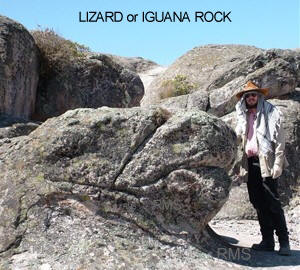 I
interpret the monuments of Markawasi as incredible
simulacra - - that is, in this case, natural objects that in the mind’s eye take
the shape of forms of other entities, such as human faces
and animals. I believe they were recognized as such even in very remote ancient
times. The weathering and erosion of the granodiorite of which the plateau is
composed gives rise to rounded anthropomorphic and
zoomorphic features that, with a little imagination and insight, can be seen as
very convincing sculptural forms. Indeed, the longer one
stays on the plateau, and the harder one looks, the more sculptures appear.
Just possibly a little retouching on the part a human hand
has enhanced some of the natural monuments, but given their heavily eroded
condition, I could not be certain. I found examples where the sculptures seem
to have been created in stages, whether or not the
creative forces were natural or man-induced. Furthermore, following a Ruppert
Sheldrake morphogenic (morphogenetic) field type of idea,
continued viewing and interpretation of the structures may have reinforced later
interpretations.
I
interpret the monuments of Markawasi as incredible
simulacra - - that is, in this case, natural objects that in the mind’s eye take
the shape of forms of other entities, such as human faces
and animals. I believe they were recognized as such even in very remote ancient
times. The weathering and erosion of the granodiorite of which the plateau is
composed gives rise to rounded anthropomorphic and
zoomorphic features that, with a little imagination and insight, can be seen as
very convincing sculptural forms. Indeed, the longer one
stays on the plateau, and the harder one looks, the more sculptures appear.
Just possibly a little retouching on the part a human hand
has enhanced some of the natural monuments, but given their heavily eroded
condition, I could not be certain. I found examples where the sculptures seem
to have been created in stages, whether or not the
creative forces were natural or man-induced. Furthermore, following a Ruppert
Sheldrake morphogenic (morphogenetic) field type of idea,
continued viewing and interpretation of the structures may have reinforced later
interpretations.
The Markawasi sculptures are point-of-view manifestations, not typical
sculptures in the round. Most can only be seen from a particular angle, and in
many cases under particular lighting conditions, be in morning, evening, a
solstice sunrise, by the light of a full moon, or under other special
conditions. Believers in the sculptures feel there are special spots that have
been designated as viewing locations, and to move even a few feet from some of
the spots means that the sculpture is obscured or not visible at all. Certain
sculptures appear to change forms as on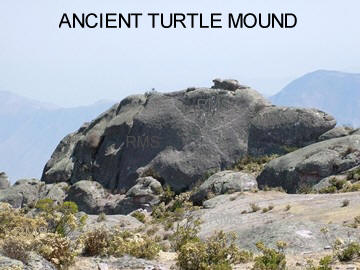 e
moves or the light changes, perhaps from a face of one race to a face of another
race. Such apparent subtlety and precision in sculpting and viewing has been
used to argue for the reality of the artificiality of the monuments, but
likewise has been advanced as strong evidence that they are simply natural
structures to which humans brings their own meaning and interpretations.
Essentially the stones and cliffs of Markawasi are like a huge Rorschach test.
Among the forms that various people, including Ruzo and others, have identified
at Markawasi are men and women of various races and nationalities, from native
South American to Semitic to African; mostly these are facial profiles, but some
of the figures consists of standing forms or reclining forms. Along with people
are a diverse array of animals such as horses, camels, elephants, lions, frogs,
seals, turtles, sphinxes, a hippopotamus, sea lions or seals, a crocodile,
lizards, and many other forms.
e
moves or the light changes, perhaps from a face of one race to a face of another
race. Such apparent subtlety and precision in sculpting and viewing has been
used to argue for the reality of the artificiality of the monuments, but
likewise has been advanced as strong evidence that they are simply natural
structures to which humans brings their own meaning and interpretations.
Essentially the stones and cliffs of Markawasi are like a huge Rorschach test.
Among the forms that various people, including Ruzo and others, have identified
at Markawasi are men and women of various races and nationalities, from native
South American to Semitic to African; mostly these are facial profiles, but some
of the figures consists of standing forms or reclining forms. Along with people
are a diverse array of animals such as horses, camels, elephants, lions, frogs,
seals, turtles, sphinxes, a hippopotamus, sea lions or seals, a crocodile,
lizards, and many other forms.
The indigenous Andean peoples had a traditional concept of wakas (guacas), which can in an abstract sense refer to laws (as laws or nature) or knowledge, or could at times be personified as heroes and deities (similar, perhaps, to the Egyptian concept of neterw or divine principles) or as cult ancestors. Wakas, it was believed, could sometimes take the physical form of uniquely shaped rocks or other natural structures. This is exactly what we may behold in the simulacra of Markawasi. The perfection and abundance of the manifestations of the wakas would make this an incredibly sacred place indeed.
There is no doubt in my mind whatsoever that Markawasi
is a very powerful, energy-filled, and sacred place. [THE STORY OF WHAT HAPPENED ]
At one spot on the plateau is a large cross, oriented to the cardinal directions, neatly incised on the surface of a precipice over looking one of the small valleys of the plateau. Sometimes referred to as the “healing cross,” an experienced dowser invariably picks up a signal when walking over it and I witnessed first-hand various colleagues as they lay on the cross with outstretched arms and experienced the mystery of the spot.
Markawasi during the dry season is a place virtually guaranteed to induce and enhance psychical, paranormal, mind altering, preternatural, consciousness-bending experiences. It is a natural laboratory for heightened sensory perception. It is no wonder that this would be a perfect site for shamanistic gatherings and ritual invocations, whether in the guise of the traditional language of symbolism and hallucinations, or modern interpretations (such as a mecca for those bent on experiencing a UFO). The high altitude, crisp air, cold nights, clear skies, hot days, the natural “stone forest,” the pre-Columbian ruins, and the sheer raw beauty, desolation, silence, and inaccessibility are mind numbing and mind expanding.
I am hesitant to talk about my own experiences at Markawasi, but I will say that I was not unmoved personally. I never observed any definitive UFOs, and I did not have an out-of-body experience, but I did feel strange tinges at times. Maybe it was simple vertigo from the high altitude, but one night while part of a group meditation I did observe a strange flash of light and two phantasms (dark, apparently shrouded, short figures standing a few yards behind another member of our group as we sat in a circle focusing our energies).
The plateau is shrouded in mystery at many levels. There is even disagreement as to the derivation of the name Markawasi (Marcahuasi). Daniel Ruzo states that the name is relatively recent and means “two-storied house,” referring to the stone buildings (which Ruzo regards as Inca military garrisons) found on the plateau. In contrast, Lisa Rome states that marca in Quecha means the land belonging to a community, and huasi means town, so the name Marcahausi refers to the land for the town or entire community, and from this etymology she suggests that the plateau was communal religious center for the surrounding area. She states that there is are no Inca remains to be found at Markawasi, dating many of the structures to the thirteenth and fourteenth centuries A.D. Others have tentatively dated some of the buildings to a good five hundred or more years earlier.
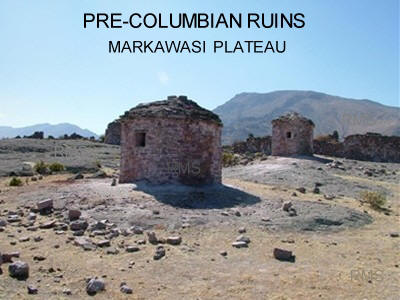
Whatever their exact age, the remains of extensive building complexes and other structures are found on the plateau. At the southern end of the plateau is the so-called fort (La Fortaleza) built upon a high butte overlooking the surrounding area and accessible only by a narrow steep path up the side that ends in a crawl-space entrance. Here pottery shards can still be found among the ruins. Elsewhere on the plateau are clusters of buildings that may have been residences, offices, places of learning, and perhaps an astronomical observatory. There are also numerous chulpas (chullpas), or tombs, to be found on the plateau, some neatly constructed of stone blocks (and in some cases rebuilt in modern times) and other tombs that simply utilized natural overhangs and shallow caves on the edge of the plateau. Bodies were bound and formed natural mummies, but most of the tombs have now been cleared out and any remains removed. We did come across human skulls and other bones in one of the more inaccessible regions, however.
The plateau is spotted with a number of artificial and natural lakes and reservoirs, most of which were dry during our August 2005 visit. Artificial dams and canal systems collect water during the rainy season and carry the water down to the village and terraced fields below the plateau.
Even today the people of San Pedro de Casta celebrate a ritual festival in October that celebrates the water that is captured on the Markawasi Plateau. According to Ruzo (1956), men opened the festival with rituals in honor of the Huari (their pre-Inca ancestors of a thousand or more years ago deified as the god Huari that was their protector; huari means giant or strong [Williamson, 1959, p. 34]), and the women and girls carry out the remainder of the ceremony over a number of days.
Virtually no ancient inscriptions are known from the plateau.
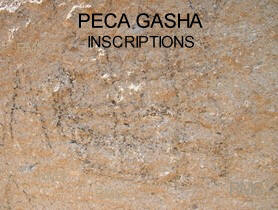
There is one major petroglyph remaining at Markawasi, although Ruzo suggested that once there must have been many. Occurring on the neck of the Pecha-Gasha, it takes the form of sixteen squares arranged in a four by four checkerboard pattern. It is somewhat irregular, being incised on a rough rock surface the lines are not perfectly straight, and the lines that it is made up or are formed from double rows of small black dots. According to Williamson (1959, p. 41-42), citing Astete and Ruzo, this is a very ancient and primordial symbol, from which many later symbols were derived, and incorporates among other ideas, the ascent and harmonization of the individual, and hence humanity, with the forces of nature and the cosmos.
The cosmos are manifest at Markawasi.
I went to Markawasi the skeptic, and came back convinced that
it is a very special, mystical, spiritual, mind-altering place.
It is an incredible site that raises many issues concerning lost civilizations, the past history of humanity, varying states of consciousness, and the nature of reality. Markawasi is a location where, more than most sites, each person brings their own notions, molds the landscape to their own thoughts, is affected in unique ways, and brings back their own perceptions. This, in my opinion, is part of the mystery and draw of Markawasi. I am determined to return to this enchanted plateau.
About the Author
Robert M. Schoch, perhaps best known for his re-dating of the Great Sphinx, is a full-time faculty member at Boston University. He lectures widely and is the author of several books, including those with R. A. McNally: Voices of the Rocks (1999), Voyages of the Pyramid Builders (2003), and Pyramid Quest (2005).
Acknowledgments
First and foremost, I thank my host Peter E. Schneider for making the trip to Markawasi possible. Bill Cote (B.C. Video) first contacted me about Markawasi, and it was due to his filming of a documentary about the plateau for Peter Schneider that I was invited to participate in the expedition. Peter and Bill kindly arranged the entire trip, Bill provided me with initial research materials about the site, and Peter put us up in his own home while we were in Lima, and gave introduction to the city. Also joining us were John Cheshire and Sean Adair (both working with Bill Cote on the documentary), Alan Matthew, Stratton Horres, and Logan Yonavjak (formerly my student at Boston University, and my field assistant for the Markawasi trip). Our local guides at Markawasi was Don Manuel, who had worked with Daniel Ruzo in the 1950s, and his son Sibriano. In Lima, I had the pleasure of meeting Javier Ruzo, grandson of Daniel Ruzo. I thank Dr. Colette M. Dowell for giving me a copy of John Michell’s book Confessions, and for monitoring my website and professional business while I was in Peru. Of course, all of the comments on Markawasi herein are my own; they do not necessarily reflect the opinions of any of the above named individuals.
By Robert M. Schoch © 2005
All photos © of Dr. Robert M. Schoch, Dr. Colette M. Dowell, Stratton Horres & BMSJ
References and Sources
Anonymous. History of the Marcahuasi Discovery. http://www.lonewolfadventure.com/marcahuasihistory.html Accessed 30 October 2005.
Cote, Bill. Marcahuasi: a mystery in stone. http://www.science-frontiers.com/sf07
sf078a03.htm Accessed 30 October 2005. (Originally published in Louisiana Mounds Society News letter, no. 42, p. 1, October 1, 1991.)
Cote, Bill, and BC Video. Peru’s Mystery in Stone. DVD, 21 minutes. See http://www.bcvideo.com/fmom12.html Accessed 30 October 2005.
Doore, Kathy. Markawasi: Remnants of a Vanished Civilization. Photography by Peter E. Schneider and Kathy Doore. http://www.labyrinthina.com/schneider.htm Accessed 30 October 2005.
Ebeling, Klaus. Marcahuasi: A Forgotten Site of Monumental Sculptures in the Peruvian Andes, Field Guide and Catalog. Manuscript (copy kindly provided to Robert Schoch by Bill Cote), 1984. 52 pages.
Hidel, Alec. George Hunt Williamson & the Genesis of the Contactees. http://www.ufomind.com/misc/1997/mar/d21-002.shtml Article dated 21 March 1997; accessed 24 October 2005.
Matthew, Alan. MARKAWASI (Marcahuasi) ~ Mystery, Myths, Mummies & More. http://www.alanmatthew.com/markawasi_cave.htm Accessed 30 October 2005.
Michell, John. Confessions of a Radical Traditionalist. (Essays by John Michell, Selected and Introduced by Joscelyn Godwin.) Waterbury Center, Vermont: Dominion, 2005.
Pinkham, Mark Amaru. The Great White Brotherhood in Peru and the Serpent Masters from Venus.
http://www.bibliotecapleyades.net/sumer_anunnaki/reptiles/reptiles21.htm Accessed 30 October 2005.
Rome, Lisa. Marcahuasi! Undated manuscript. 11 pages.
Rome, Lisa. Markawasi Mysteries in Stone. Photography by Kathy Doore and Peter Schneider. http://www.labyrinthina.com/marcahua.htm Accessed 30 October 2005.
Ruzo, Daniel. El Testamento Auténtico de Nostradamus. Barcelona: Plaza & Janes, 1975.
Ruzo, Daniel. El Valle Sagrado de Tepoztlan: Los Temples Atlantes de México. Lima: Editorial Mundo Hispano S.R.L., 1978 (fourth edition).
Ruzo, Daniel. La Culture Masma. L’Ethnographie: Revue de la Société d’Ethnographie de Paris. 1956. Pp. 45- 53.
Ruzo, Daniel. La Culture Masma. L’Ethnographie: Revue de la Société d’Ethnographie de Paris. 1959. Pp. 75-87.
Ruzo, Daniel. Marcahuasi: La Historia fantástica de un Descubrimiento. Lima: Ignacio Trapero, 2004 (Originally published in 1974; copy given to Robert Schoch by Javier Ruzo, August 2005).
Ruzo, Daniel. Le plus ancien "haut-lieu" du monde? Planète, no. 3. Paris, February-March 1962. Pp. 40-47.
Ruzo, Daniel. Preliminary Investigations of an Unknown American Race. Communication made before the National Academy of Sciences of Mexico on January 19, 1953. (English translation by Irene Nicholson. Provided to Robert Schoch by Bill Cote.)
Shapiro, Joshua. Peru: The Land of UFOs? http://www.v-j-enterprises.com/peruart.html Article dated December 1990, accessed 30 October 2005.
Tenuta, Gary Val. A Master Occultist, An Egyptian Governmental Official & the Face on Mars: Synchronistic Bedfellows Or Cosmic Coincidence? http://www.think-aboutit.com/Mars/a_master_occultist.htm Accessed 30 October 2005.
Williamson, George Hunt. Road in the Sky. London: Neville Spearman, 1959 (third impression, 1969).
![]()
CIRCULAR TIMES ALTERNATIVE MAGAZINE
An International Networking Educational Institute
Intellectual, Scientific and Philosophical Studies
Copyright © 1995-2007
Website Design for the previous page of Dr. Robert M. Schoch and Circular Times
and all contents including but not limited to text layout, graphics, any and all images, including videos are Copyright © of Dr. Colette M. Dowell, 1995-2007